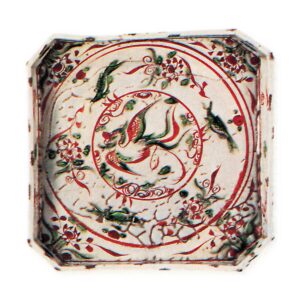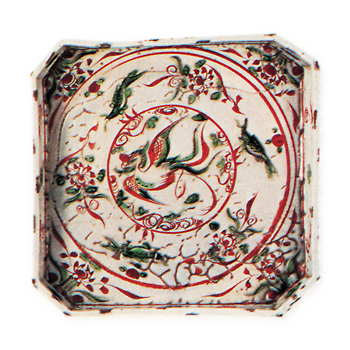
Kyoyaki is the general term for all ceramics produced in Kyoto. Kyoyaki, like other industries in the region, has developed artistically and has always held a leading position over other regions. Although Nonomura Ninsei (1624-44) is credited with the development of kyoyaki, the history of kyoyaki in Kyoto goes far back before that. Although Kyoto produced some ceramic materials, they could only be used for miscellaneous items, and Shigarak clay from Omi (Shiga Prefecture) was the only other high-quality local material. However, this has the advantage of allowing for greater freedom in the formulation and variety of ingredients. As the site of a royal castle for many years, Kyo-yaki had the best culture, convenient transportation, and frequent comings and goings of master craftsmen from all over the country, so it was possible to gather techniques from all over the world, refine them, and then pass them on to other countries. The value of Kyo-yaki lies not so much in its industry as in its arts and crafts. Each potter’s work is generally marked with his or her own name or kiln mark, and the individuality of each potter is evident in his or her work, just as it is in a painting or sculpture.
The origin and history of Kyoto ceramics are not known, but according to old histories, during the reign of Emperor Osotsugu, potters in Yamabusa Domestic Village (Uji City, Kyoto Prefecture) and Ochomi Village (Fushimi-ku, Kyoto City) were given the task of making pottery for the emperor’s guests. There is no historical record of the pottery for the next several hundred years. During the reign of Emperor Shomu, the monk Gyoki issued an imperial decree and built a kiln in Seikanji Village, Atago-gun, Yamashiro Province (Seikanji, Higashiyama-ku, Kyoto City) to produce earthenware. The site is said to be the present-day Chawanzaka (Tea Bowl Hill). This may have been the beginning of pottery production in Kyoto. During the Enryaku era (782-806), during the reign of Emperor Kanmu, a kiln was built at Takagamine in the northern part of Kyoto and heki kawara (blue tiles) were produced. During the Genryaku era (1184-5), earthenware was produced in Fukakusa in the southern part of Rakunan, but it was crude and unglazed, and was commonly referred to as pottery.
During the Houtoku era (1449-62), Otowaya Kuroemon discovered the ruins of Chawanzaka and moved his kiln to Fukakusa to produce pottery, but it was not yet solid enough. During the Eisho period (1504-21), Motoyoshi of Shibuya took pains to improve this road using the old Fukakusa method, and finally discovered the glaze and later moved his kiln to Kiyomizu. A Korean man, A Yomi, was naturalized and lived in Kyoto at that time and invented a kind of pottery.
In 588, Toyotomi Hideyoshi (16th year of the Tensho Era) built the Jurakuji Palace and invited Chojiro to make tea bowls with red and black glaze according to the design of Sen no Rikyu. It was so fine that Hideyoshi awarded Chojiro with the gold seal of the Raku character for it.
Thereafter, Chojiro named the pottery he made Raku ware with this seal. From Tensho to Keicho (1573-1615), master potters such as Masayi, Man’emon, Sohaku, Rokuzaemon, Sozo, Gen, and Genjuro were produced and lived in Otowa Seikanji and Komatsudani Shimizu, and engaged in pottery production as Otowaya and Maruya. They were the pioneers of Kyoto kilns. At the end of Keicho, the kiln was ordered to move to Gojozaka because the smoke from the kiln covered the mausoleum of Prince Toyo in Amidagamine, and the kiln was moved to Gojozaka. According to one theory, a man named Otowaya Sozaemon of Chawanzaka was engaged in pottery production for generations, but the business declined after nine generations of descendants, and in 1819 (Bunsei 2) the kiln was given to a man named Maruya Sahei of Kanecho-cho on the grounds of Daibutsu (Hokoji Temple), who moved it to the back of his residence. This is said to be the founder of the Gojozaka pottery kiln. It is also said that the kiln was moved to Gojozaka in 1613 when the huge bell of the Daibutsu (Great Buddha) was cast. In 1624, a potter from Owari Seto, Sanjiya Kuemon, came to Awataguchi Sanjo-dori Keage to make tea utensils. His products are all stamped with the cursive Awata mark. This is said to be the origin of Awata ware. During the Kan’ei era (1624-44), a man named Nonomura Seiwemon built a kiln in Kiyomizu Sanneizaka and produced pottery that was highly praised by the public. Later, he opened pottery kilns in Awataguchi, Omuro, Gobosatsu-ike (Fukadori-ike), Seikanji, Iwakura, Narutaki, Takagamine, Komatsudani, etc., and served the Ninna-ji Palace with his work, which earned him the character “Nin” from the palace. He was given the character “Nin” by the palace, and thus took the name “Insei”. He produced tea sets, water jars, plates, bowls, and other wares, which were made according to the pottery methods of Nagato Matsumoto Chikuzen Takatori, Omi Shigaraki, Owari Seto, Nanban, and Korea, and each vessel bears the Inseong mark. The quality is not hard and rigid, and the glaze is peaceful, lofty, elegant, and dignified. During the Meireki era (1655-8), a potter named Chawan-ya Kyubei learned the secret of Hizen nishikide from Aoyama Koemon, a potter in Arita, Hizen, and passed it on to Insei. Inikiyo learned the technique of nishiki-te from Aoyama Koemon, a Hizen Arita potter. This was the beginning of the color painting method in Kyoto. Later, the Insei school split into two. Awata ware was the first to introduce the technique of painting with soft glaze. Awata ware was introduced to this school, which included Kinmitsuyama Sohei, Tanzan Seikai, Hozan Bunzo, and Obiyama Yohei. In recent years, they have produced gold-painted flower-and-bird and mountain-and-river porcelains, which are extremely beautiful. Another school is Kiyomizu porcelain. In the Bunka era (1804-8), Takahashi Michihachi (called Niami), Wake Kame-Tei, and Mizukoshi Yosanbei were the first to produce blue-and-white porcelain according to the Hizen-Arita method. Most of them made their works by finger-heads and did not use models. The painting method was also skillful. He invented a type of ceramic technique based on the method of Hon’ami Koetsu, and copied a kind of painting style using black, blue, purple, red, and other colors based on Dutch Chinese clay glazes. The light painting has a unique flavor.
Each piece is inscribed on the reverse side with the inscription “Shicui Qianzan” or “Shicui Shenzhen”. This is so-called Qianshan ware. The surface of the pottery is decorated with deeply inventive freehand paintings of plants, birds, and beasts, as well as landscapes in intricate paintings, and the delicacy of the work is apparent at a glance. The Kansei period (1789-1801) saw the emergence of Okuda Yonkawa. He was born into a wealthy merchant family and built a kiln in Awata. His products are also excellent. He was especially good at imitating red glaze and gosu.
He also liked to produce pottery in imitation of old dyeing and kojigama kilns, and his work was very skillful and elegant. Among his pupils were such master craftsmen as Kikume, Michihachi, Sukesuke, and Kasuke. Kikume opened a kiln in Awata during the Bunsei era (1818-30) and later moved to Kiyomizu.
He was elegant, out of the ordinary, and extremely well-read.
After starting to work as a potter, he painstakingly tried to surpass his predecessors, Insei and Qianzan. He found the “Theory of Pottery” to be very helpful, and invented the glaze method of fire, which was a breakthrough. Although the traditional glaze method was already open, it was not yet complete. The development of wood rice was a major breakthrough and made a great contribution to the pottery industry. He was associated with writers and artists such as Sanyo Rai and Tanomura Takeda, and in his later years, he reprinted “Tōshi” (The Story of Ceramics), for which Sanyo wrote the preface. He was indeed an eccentric among potters. Before him, there was another potter named Zengoro Shoji, who, in his spare time from making clay furnaces, made porcelain and was skilled at imitating ancient Japanese and Chinese vessels. There is also a piece of porcelain made in China during the Yongle period (1403-24) that was glazed with red and painted with ancient designs in gold powder, based on a technique called kinrande. They were also skillful in imitating koji-yaki Xiangdan ware. The Kii family loved it and gave it the mark of Eiraku, which was the beginning of Eiraku ware. This was the beginning of Eiraku ware. At that time, there was a man named Wakei Heikichi, who called himself Kame-Tei. He was enthusiastic about the improvement of ceramics, and since there were few people producing blue-and-white porcelain on Gojozaka, he sought to improve and develop this art. In 1812, he sent his student Kameya Kumakichi to visit kilns in various regions to study the secrets of porcelain. Kumakichi mastered the secret techniques at Arita, and from this point on, the porcelain manufacturing methods of Gojo and Shimizu were greatly improved.
There was an earlier Shuhei Ogata, a younger brother of Niami. He lamented the lack of perfection in the method of gold and silver painting on ceramics at the time, and constantly studied the method, gaining much from it and contributing greatly to the world of porcelain. During the Bunkyu era (1861-4), a man named Mikiyama Denshichi came from Seto, Owari, and built a round kiln in Shimizu. This was the first round kiln in Kyoto, and also the first to produce porcelain in a large format. Since then, potters in general have been trying to improve and develop their main business with a unique artistic conception. The late Bunsei period (1818-1830) was especially noted for the most exquisite Kyo-yaki pottery. (“History of Japanese Ceramics in the Early Modern Period”)


